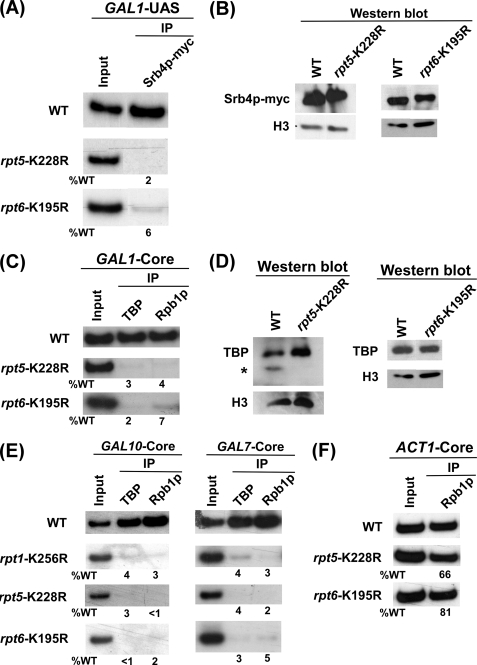FIGURE 6.
19 S ATPases function in a cooperative manner for formation of the transcription complex assembly. A, recruitment of Mediator to the GAL1 UAS is impaired in rpt5-K228R and rpt6-K195R point mutant strains. The wild type (WT) and mutant strains expressing Myc epitope-tagged Srb4p were grown and cross-linked as in Fig. 3B. Immunoprecipitation was carried out as in Fig. 3B. B, Western blot analysis is shown. The wild type and mutant strains were grown as in panel A. The whole cell extracts from the wild type and mutant strains were prepared as in the ChIP assay. The whole cell extracts were analyzed by Western blot assay using the anti-Myc and anti-histone H3 antibodies against Myc-tagged Srb4p and histone H3, respectively. C, analysis is shown of TBP and RNA polymerase II recruitment to the GAL1 core promoter in rpt5-K228R, rpt6-K195R, and wild type strains. The wild type and point mutant strains were grown and cross-linked as in panel A. Immunoprecipitation was performed as in Fig. 4A. D, Western blot analysis is shown. rpt5-K228R and rpt6-K195R point mutant and wild type strains were grown as in panel A. The whole cell extracts from the wild type and mutant strains were prepared as in the ChIP assay. The whole cell extracts were analyzed by Western blot assay using the anti-TBP and anti-histone H3 antibodies against TBP and histone H3, respectively. E, 19 S ATPases are essential for the PIC formation at the GAL7 and GAL10 promoters. The wild type and 19 S ATPase point mutants were grown and cross-linked as in panel C. Immunoprecipitation was carried out as in panel C. The primer pairs located at the core promoters of the GAL7 and GAL10 genes were used for PCR analysis of the immunoprecipitated DNA samples. F, analysis is shown of RNA polymerase II recruitment to the ACT1 core promoter in the wild type and rpt5-K228R and rpt6-K195R point mutant strains. The wild type and mutant strains were grown and cross-linked as in panel C. Immunoprecipitation was carried out as in panel C.

